live Russian air attack on Ukraine kills three
A massive Russian strike on Ukraine killed at least three people, including a four-year-old, as air raids and power outages hit cities nationwide. Pre...
Eid al-Adha, known as the "Festival of Sacrifice," stands as one of Islam's most significant celebrations, commemorating Prophet Ibrahim's willingness to sacrifice his son in obedience to Allah's command.
This sacred holiday will be observed from June 6-9, 2025, marking the culmination of the annual Hajj pilgrimage and bringing together over 1.8 billion Muslims worldwide in a demonstration of faith, charity, and community unity. The festival generates billions of dollars in economic activity globally while reinforcing the fundamental Islamic values of sacrifice, obedience, and generosity toward those in need.
Understanding Eid al-Adha: Religious Significance and Meaning
The Foundation of Faith
Eid al-Adha derives its profound meaning from the Arabic word "Adha," which means "sacrifice" and has its root in "duha," meaning "light" or "illumination". The festival commemorates the pivotal moment when Prophet Ibrahim (Abraham) received a divine command in a dream to sacrifice his beloved son Ishmael (Ismail) as an act of absolute obedience to Allah. This test of faith represents the ultimate submission to divine will, embodying the very essence of Islam, which means "surrender".
The story, as recounted in the 37th chapter of the Holy Quran, demonstrates unwavering faith when both father and son accepted Allah's command without question. As Ibrahim prepared to carry out the sacrifice, Allah intervened through the Angel Gabriel, providing a ram as a substitute and declaring that the test had been fulfilled. This divine mercy established the tradition of animal sacrifice that continues to this day, symbolizing the believer's willingness to give up what is most precious in service to Allah.
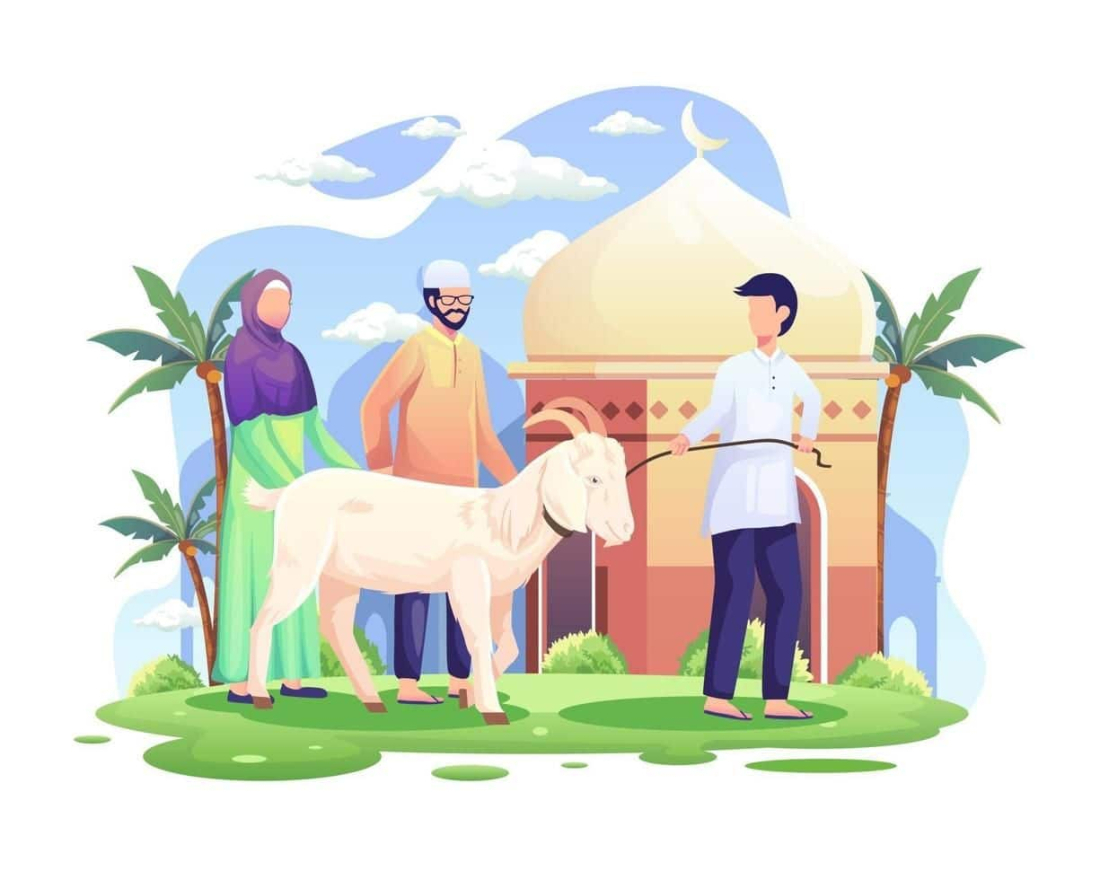
Spiritual Dimensions and Core Values
Eid al-Adha serves as an annual reminder that life itself is a test requiring constant submission and obedience to Allah. The festival emphasizes four fundamental Islamic values: faith (iman), obedience (ta'ah), charity (sadaqah), and community (ummah). These principles guide Muslims in their daily lives and are particularly highlighted during this sacred time when families gather to pray, share meals, and support those less fortunate.
The holiday's spiritual significance extends beyond individual worship to encompass collective responsibility. Muslims are reminded that true success comes not from material wealth but from spiritual purification and service to others. This emphasis on community welfare transforms Eid al-Adha from a personal celebration into a global movement of solidarity and compassion.
Eid al-Adha 2025: Key Dates and Timing
Official Celebration Dates
Eid al-Adha 2025 will begin at sunset on June 6, 2025, corresponding to the 10th day of Dhul Hijjah in the Islamic lunar calendar. The celebration officially continues through June 9, 2025, though some countries extend festivities for additional days. The Day of Arafah, which precedes Eid al-Adha, falls on June 5, 2025, marking the climax of the Hajj pilgrimage when millions of pilgrims gather on Mount Arafat.
Regional Variations and Public Holidays
Different countries observe varying holiday durations based on local customs and government declarations. The United Arab Emirates has announced a four-day public holiday from June 5-8, 2025, covering both Arafah Day and Eid al-Adha. Qatar extends the celebration to five days, from June 5-9, while Saudi Arabia traditionally observes two weeks of festivities. These extended celebrations reflect the holiday's profound cultural and economic significance across Muslim-majority nations.
The timing follows the lunar calendar, causing Eid al-Adha to occur approximately 10 days earlier each year compared to the Gregorian calendar. This lunar-based calculation ensures that the festival rotates through all seasons over a 33-year cycle, allowing Muslims worldwide to experience the celebration in different seasonal contexts.
The Historical Story of Prophet Ibrahim
The Divine Test
The historical foundation of Eid al-Adha rests on one of the most powerful narratives in Islamic tradition, demonstrating the ultimate test of faith. Prophet Ibrahim, who had long desired a son and received divine prophecy of a righteous heir, faced the most challenging command when Allah instructed him to sacrifice his beloved son Ishmael. This test came when Ishmael was approaching puberty, making the sacrifice even more emotionally devastating for the devoted father.
The Quran records Ishmael's remarkable response to his father's revelation: "O my father! Do as you are commanded. If Allah wills, you shall find me of the patient". This dialogue demonstrates not only Ibrahim's faith but also Ishmael's willing submission to divine will, establishing a model of obedience that resonates throughout Islamic history.
The Triumph of Faith Over Temptation
During this period of trial, Shaytan (Satan) attempted to dissuade Ibrahim from carrying out Allah's command, visiting him three times to plant seeds of doubt. Ibrahim's response was to throw stones at the tempter, an action commemorated today during the Hajj pilgrimage when pilgrims symbolically stone the devil at Mina. This element of the story emphasizes the constant struggle between divine obedience and worldly attachments .

When the moment of sacrifice arrived, Allah's mercy intervened through the Angel Gabriel, who brought a ram to substitute for Ishmael . This divine intervention demonstrated that Allah does not desire the sacrifice of innocent life but rather the demonstration of absolute faith and willingness to surrender everything for divine pleasure.
Core Traditions and Rituals
The Eid Prayer and Morning Observances
Eid al-Adha begins with special congregational prayers performed any time after sunrise and before the Zuhr (noon) prayer. Muslims dress in their finest clothing and gather in large congregations at mosques, Islamic centers, or designated prayer grounds called Eidgah. The prayer is followed by a khutbah (sermon) that reinforces the spiritual messages of sacrifice, charity, and community solidarity.
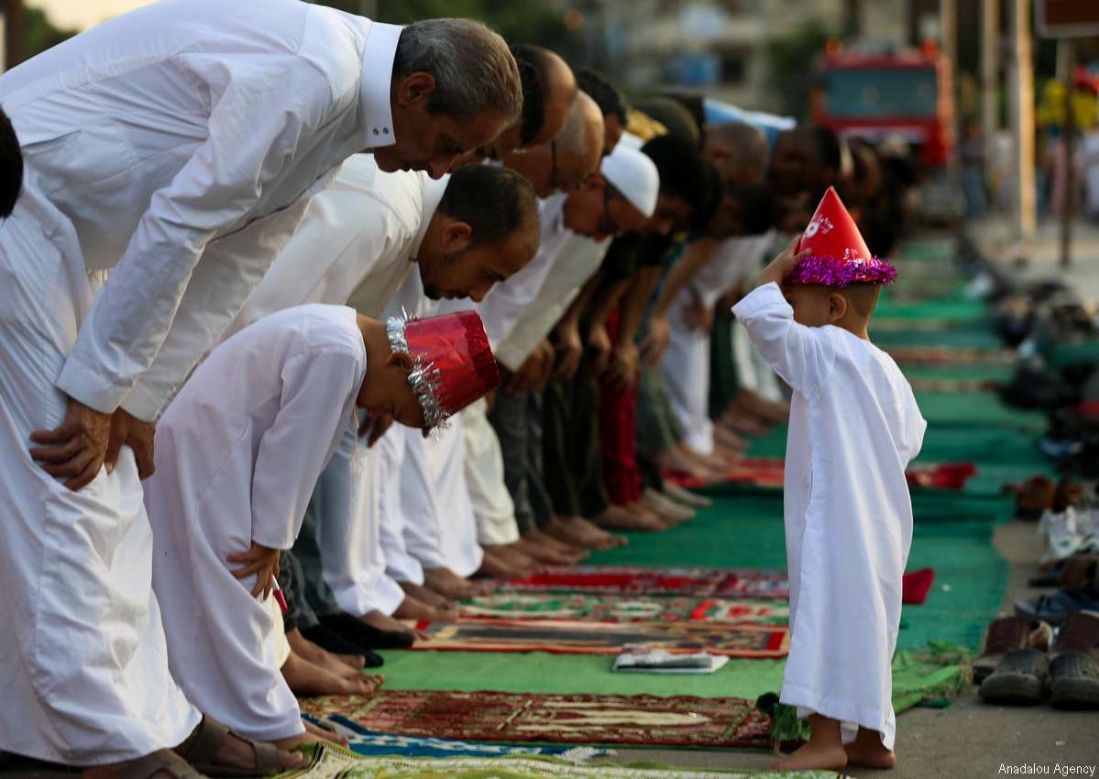
During the pre-Eid period and throughout the celebration, Muslims recite the takbir, special prayers of glorification that acknowledge Allah's greatness. These recitations create a spiritual atmosphere that permeates Muslim communities worldwide, unifying believers across geographical and cultural boundaries.
Qurbani: The Ritual Sacrifice
The central ritual of Eid al-Adha is qurbani, the sacrificial offering of halal animals including camels, cows, goats, sheep, or rams. The animals must meet specific age and quality standards: at least one year old for sheep and goats, two years for cows and buffalo, and five years for camels. These requirements ensure that only healthy, mature animals are offered, reflecting respect for the sacrifice being made.
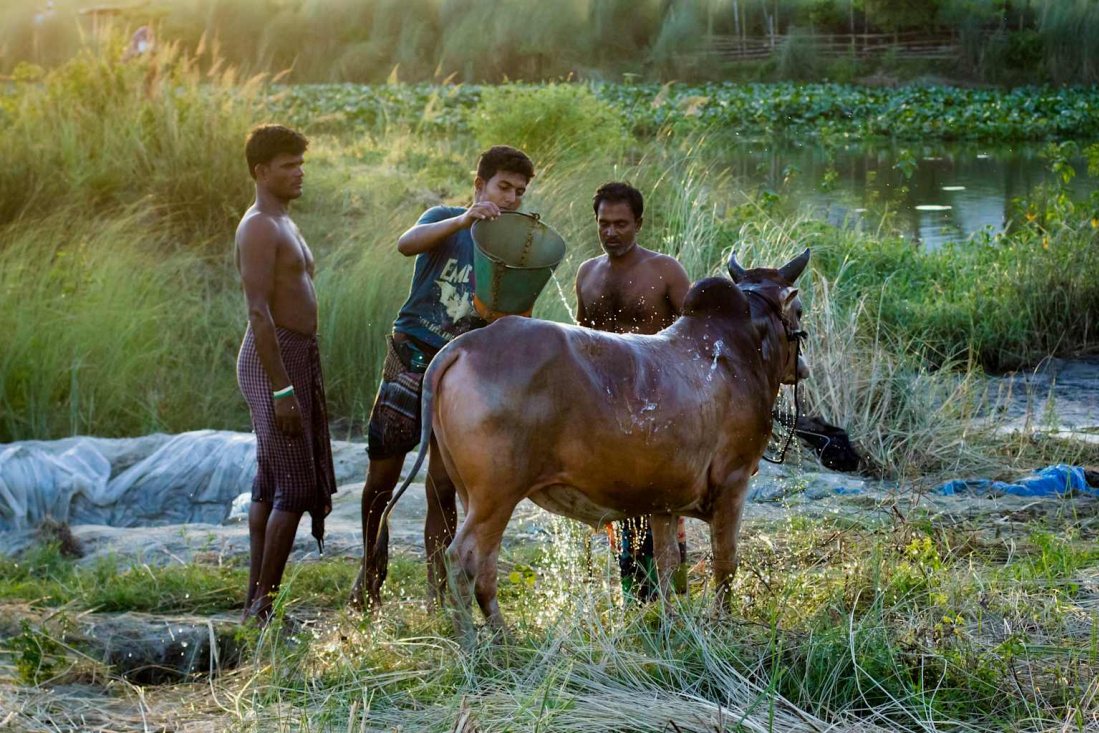
The sacrifice process follows strict Islamic guidelines designed to minimize animal suffering and maintain spiritual reverence. The animal must be treated with kindness, fed well, and calmed before the procedure. A sharp knife is used to ensure a swift, humane sacrifice, and the words "Bismillahi Allahu Akbar" (In the name of Allah, Allah is Greatest) are recited. The animal should not be skinned until the body is completely cold, and no animal should be slaughtered in the presence of others.
Distribution and Charity
Islamic tradition mandates that the meat from sacrificed animals be divided into three equal portions: one-third for the family, one-third for friends and relatives, and one-third for the poor and needy . This distribution system ensures that even the most disadvantaged community members can participate in the festive meals, embodying the Islamic principle that everyone deserves to eat meat during this blessed time .
For Muslims who cannot afford to purchase an animal individually, Islamic scholars permit up to seven people to share in the sacrifice of a larger animal such as a cow or camel . This accommodation ensures that financial constraints do not prevent believers from participating in this fundamental ritual .
Global Celebrations and Cultural Variations
Worldwide Observance
Eid al-Adha is celebrated across more than 50 countries with significant Muslim populations, creating a truly global festival that transcends national and cultural boundaries . From Indonesia, home to the world's largest Muslim population of over 200 million, to smaller communities in Western nations, the festival adapts to local customs while maintaining its core spiritual elements .
In Indonesia, the morning begins with communal prayers at mosques followed by gift exchanges and family gatherings . The country's diverse ethnic landscape, comprising over 300 groups, creates one of the world's most vibrant Eid celebrations, blending Islamic traditions with local cultural practices .
Regional Customs and Practices
Pakistan observes Eid al-Adha for four full days, with extensive preparations beginning weeks in advance . The country's significant livestock industry sees approximately 6.8 million animals sacrificed annually, representing a 9.7% increase from previous years and generating economic activity worth over PKR 839 billion . This massive undertaking involves temporary employment for hundreds of thousands of workers in livestock, logistics, and retail sectors .
Malaysia offers another compelling example of multicultural Eid celebrations, particularly in Kuala Lumpur where diverse communities participate in the festivities . The capital city becomes a hub of activity with special markets, charitable distributions, and cultural programs that showcase the harmony between Islamic traditions and Malaysian diversity .
Turkey's celebrations center around historic mosques such as the Blue Mosque and Hagia Sophia, where thousands gather for prayers . The country's rich Ottoman heritage adds unique architectural and cultural elements to the celebrations, making Turkish Eid observances particularly meaningful for visitors and locals alike .
Economic and Social Impact
Global Economic Significance
Eid al-Adha generates substantial economic activity across multiple sectors, with global estimates reaching billions of dollars annually . The festival drives demand in agriculture, livestock, retail, food services, and logistics, creating a ripple effect that benefits entire economies . In Pakistan alone, the economic impact reaches approximately PKR 839.2 billion, equivalent to about 1% of the country's annual GDP .
The livestock industry experiences its peak season during Eid al-Adha, with Bangladesh receiving 50-60% of its annual hide supply from festival sacrifices . This concentration of activity fuels both domestic leather processing and export-oriented industries, contributing significantly to foreign exchange earnings . The temporary employment generated includes positions in livestock management, transportation, retail, hospitality, and food processing .
Retail and Consumer Impact
Consumer spending surges dramatically during Eid al-Adha as families purchase new clothing, gifts, home decorations, and festive foods . E-commerce platforms experience significant increases in orders, requiring enhanced logistics and delivery solutions to meet demand . Traditional markets and modern shopping centers both benefit from increased foot traffic and sales volumes .
The food and beverage sector sees heightened demand for meat, spices, and specialty ingredients used in traditional Eid dishes . Restaurants and catering services experience increased patronage as families celebrate together, often hosting large gatherings that require professional food preparation services . Cold chain logistics become particularly crucial for maintaining meat freshness and safety from processing facilities to retail outlets .
Social and Community Benefits
Beyond economic impacts, Eid al-Adha strengthens social bonds within Muslim communities and promotes interfaith understanding . The mandatory sharing of sacrificial meat ensures that economically disadvantaged families receive protein-rich food, addressing food security concerns during the celebration period . This charitable aspect demonstrates Islam's emphasis on community welfare and social responsibility .
Rural communities particularly benefit from Eid al-Adha activities, as urban Muslims often source animals directly from farmers . This direct trade relationship provides substantial income for rural livestock producers, supporting agricultural communities and contributing to rural development . The festival thus serves as an important mechanism for wealth distribution from urban to rural areas .
Modern Celebrations in the Digital Age
Digital Connectivity and Virtual Celebrations
Contemporary Eid al-Adha celebrations increasingly incorporate digital technologies to maintain connections across global Muslim communities . Social media platforms facilitate the sharing of greetings, photos, and live streaming of celebrations, allowing extended families separated by geography to participate virtually in festivities . According to research, 84% of American Muslims use social media to connect with their faith community, making digital greetings essential for maintaining spiritual bonds .
The COVID-19 pandemic accelerated the adoption of virtual celebration elements, with many communities continuing these practices even as in-person gatherings resumed . Live streaming of Eid prayers, virtual family gatherings, and digital charity collections have become permanent features of modern Eid observances .
Technology in Charity and Qurbani
Modern technology has revolutionized charitable giving during Eid al-Adha, with digital platforms facilitating zakat payments and qurbani contributions . Online calculators help Muslims determine their zakat obligations, while digital payment systems enable instant transfers to charitable organizations worldwide . Many Muslims now contribute to qurbani programs in developing countries through international relief organizations, ensuring that their sacrificial obligations benefit the global ummah .
Mobile applications provide real-time updates on Eid dates, prayer times, and local celebration activities . These tools help Muslims maintain religious observances while adapting to busy modern lifestyles, ensuring that spiritual obligations remain accessible regardless of location or circumstances .
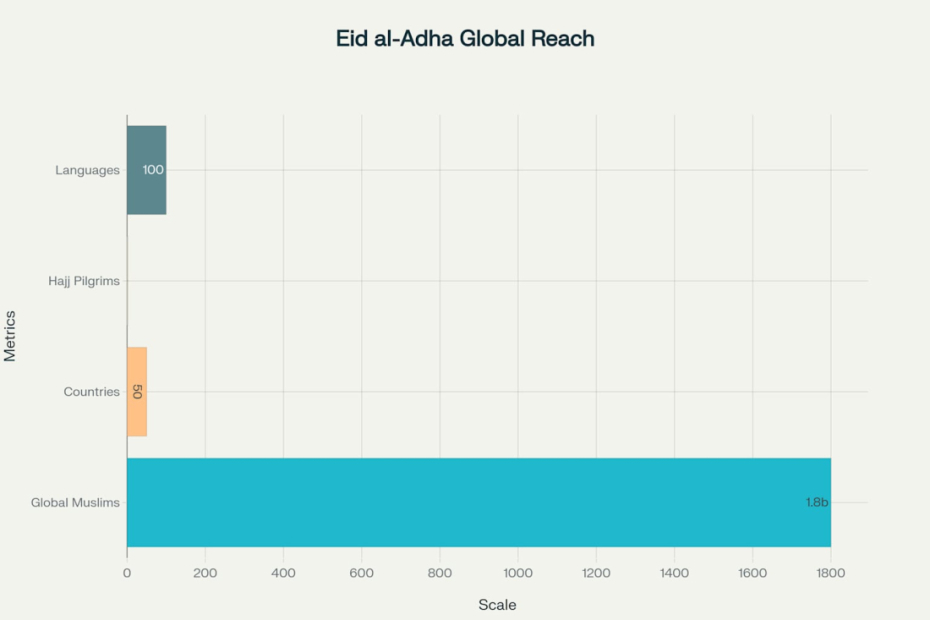
Eid al-Adha and Hajj Connection
The Pilgrimage Culmination
Eid al-Adha holds special significance as it marks the climax of Hajj, the annual pilgrimage to Mecca that represents the fifth pillar of Islam . Over 2 million pilgrims gather annually in Saudi Arabia to perform this sacred journey, creating one of the world's largest peaceful assemblies . The Day of Arafah, preceding Eid al-Adha, represents the spiritual pinnacle of Hajj when pilgrims stand in prayer and contemplation at Mount Arafat .
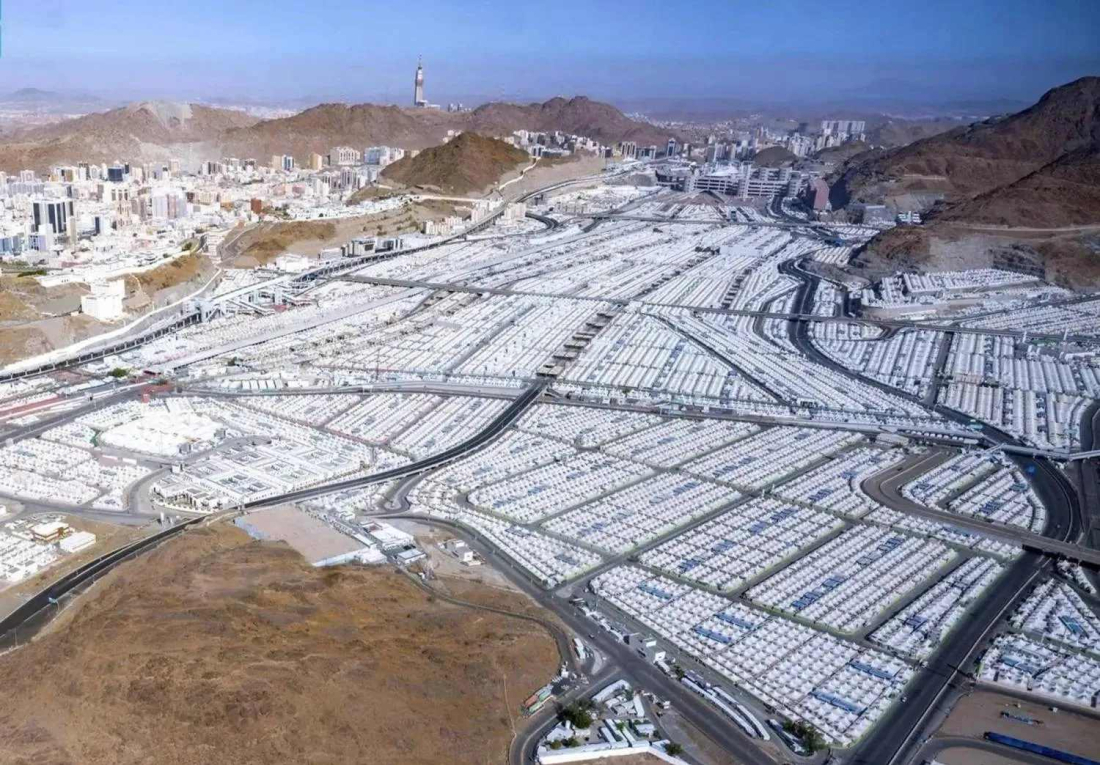
The synchronization between Hajj and Eid al-Adha creates a global spiritual connection, as Muslims worldwide celebrate while pilgrims complete their sacred journey . This timing ensures that the entire Muslim ummah participates in a unified moment of worship and celebration, regardless of their physical proximity to Mecca .
Spiritual Unity and Global Participation
While only a fraction of Muslims can physically perform Hajj due to financial and logistical constraints, Eid al-Adha allows all believers to participate in the spiritual benefits of this sacred time . The festival provides an opportunity for spiritual renewal and recommitment to Islamic values, mirroring the transformative experience of Hajj pilgrims .
The global celebration during Hajj season demonstrates Islam's universal nature, transcending national, ethnic, and linguistic boundaries . Muslims in diverse locations perform similar rituals of prayer, sacrifice, and charity, creating a worldwide community of worship that reinforces the concept of ummah (global Muslim community) .
Conclusion
Eid al-Adha 2025 represents far more than a religious holiday; it embodies the fundamental principles of faith, sacrifice, and community solidarity that define Islamic civilization . From June 6-9, 2025, over 1.8 billion Muslims worldwide will participate in this sacred celebration, generating billions of dollars in economic activity while reinforcing the spiritual bonds that unite the global ummah .
The festival's enduring relevance lies in its ability to adapt to contemporary circumstances while maintaining its core spiritual message . Whether through traditional animal sacrifice, digital charity platforms, or virtual family gatherings, Eid al-Adha continues to serve its fundamental purpose of bringing communities together in worship, gratitude, and service to those in need .
As Muslims prepare for Eid al-Adha 2025, the festival stands as a powerful reminder that true prosperity comes not from material accumulation but from spiritual purification and charitable service . The story of Prophet Ibrahim's willingness to sacrifice what he held most dear continues to inspire believers to examine their own priorities and recommit to the values of faith, obedience, and generosity that form the foundation of Islamic life .
Vince Zampella, co-creator of the Call of Duty franchise, has died after a Ferrari crash on Angeles Crest Highway north of Los Angeles.
Israeli Prime Minister Benjamin Netanyahu said Israel is monitoring recent Iranian military exercises and will raise the issue with U.S. President Donald Trump during his visit to Washington next week.
A major power outage swept across San Francisco on Saturday, leaving up to 130,000 customers without electricity, disrupting traffic and forcing some businesses to close temporarily, officials said.
Israel’s government has approved the creation of 19 new Jewish settlements in the occupied West Bank, a move that analysts say further undermines the prospects for a viable Palestinian state.
Swedish customs officials have boarded a Russian freighter anchored in Swedish waters after confirming that the vessel and its owners are subject to European Union and U.S. sanctions.
A massive Russian strike on Ukraine killed at least three people, including a four-year-old, as air raids and power outages hit cities nationwide. President Zelenskyy condemned the attack, urging greater pressure on Moscow.
Negotiations conducted with the United States and European nations, aimed at ending the nearly four-year war with Russia, were "very close to a real result," Ukrainian President Volodymyr Zelenskyy said on Monday.
Start your day informed with AnewZ Morning Brief: here are the top news stories for the 23rd of December, covering the latest developments you need to know.
The U.S. State Department has authorised a potential Foreign Military Sale of Advanced Medium Range Air‑to‑Air Missiles (AMRAAM) to Denmark, aimed at bolstering the Scandinavian nation’s air defence capabilities, the Pentagon’s Defence Security Cooperation Agency said on Monday.
Canadian Prime Minister Mark Carney has announced the appointment of Mark Wiseman, a former global investment banker and head of Canada’s largest pension fund, as the country’s next ambassador to the United States.
You can download the AnewZ application from Play Store and the App Store.

What is your opinion on this topic?
Leave the first comment